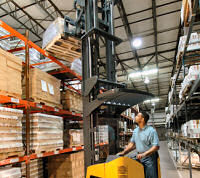| INFORMATION: Free information is available from CHESS on the subject in this story. Click here to request a copy |
 Warehouse Management Systems (WMS) are reaching serious levels of complexity.
Warehouse Management Systems (WMS) are reaching serious levels of complexity.
More and more is going into them and this is reflected in the price end users are asked to pay. So why are some customers not using significant parts of their systems functionality? First, many companies have inadequately trained staff who find it difficult to take the system on to a new level. In some cases employees might not have the right aptitude to use a complex software solution. This reduces the potential benefit from systems and users ultimately lose out on their investment.
Time pressure
Pressure of time and lack of resource is the second, and perhaps commonest, problem. A WMS might have been implemented to a certain level to get the job done on a daily basis. But due to pressure imposed by the environment staff have neither the time or inclination to grapple with new areas of the system. The lean management operated by many companies (especially in the 3PL sector) only makes this worse. Call in external specialist help, if necessary, either from the vendor or perhaps an independent project manager who can make things happen quickly for a sensible short term outlay. Over the top functionality is the third reason, and also surprisingly common. In many cases customers have simply over-specified their requirements and bought something to match. They eventually find the daily demands of their operation are simpler, leaving functions unused and superfluous.
So much for the problems, what can end users do about them? First, customers frequently under invest in system training. This is a mistake. The reality is that it is not possible to train people (even very able ones) to understand everything in a WMS during pre-live training sessions. Training, especially for more competent operators, should be a continuous process because it provides users with gradual exposure to the systems full potential. Time must be made available for continued implementation. The industry strives to keep its warehouses full and its vehicles wheels turning so why not keep an expensive software solution busy too?
People should look closely at what they are buying and why. Many WMS suppliers make great play of features available in their systems, although these are often peripheral to the users key requirement. The marketing pitch would suggest that warehouses cant possibly function without XYZ. The fact is many people are functioning quite well without XYZ, and a lot of other stuff besides. So is it the case that people are buying products that are too complex for their needs? In many ways the answer to the question is yes, and it is quite possible to spend considerable sums doing it. But if the functionality is not required the investment is wasted.
Tiered Logic
Perhaps a more important factor is finding a solution that can be developed when needed. Standard vendor upgrades are good, but they do not always provide the required functions or features. A system that supports customised elements as well as maintaining the potential for upgrades offers greater benefit. Development of unique system elements is made easier by a good design architecture which allows the addition of non-standard features while leaving the upgradeable core solution intact. This is supported, for example, by Tiered Logic, where layers of the software application can replace or augment the standard code in order to create new process flows. Ultimately this approach may not necessarily mean a lower cost solution, but it will probably mean that the investment delivers something that is going to be used and for that reason it represents a better investment.

Add a Comment
No messages on this article yet